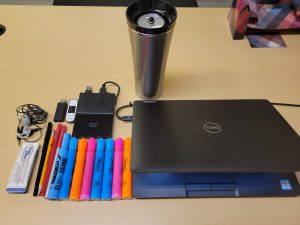My name is Jacob Gleckman, I teach high school social studies. I chose to examine the contents of my work backpack, the only bag I consistently use. In this bag I have:

- My work laptop that I use daily. It contains my daily plans and lessons for my courses, serves as my main research tool when preparing new lessons, a communication device, my paperless classroom delivery tool, and music player.
- A portable hard drive as an emergency backup to my course content. This largely sits in a pocket untouched.
- A couple of USB sticks that contain even more backups of course content. In the rare situation they have helped transfer student files when wifi was down. These are used even less than the hard drive.
- Several highlighters that I used to use to fill in rubrics when marking, but are now just for indicating when I’ve input student grades from my physical grade book into my digital one. The bright colour in my grade book makes distinguishing recorded, unrecorded, and unsubmitted assignments easily.
- Two red pens, one of which I think is low on ink, are only for recording student scores in my physical grade book. I find the red is easier to read when entered in the tightly knit grid of paper gradebooks.
- A black pen to write over red scores in my gradebook. Sometimes I make a mistake, or a student improves an assignment. The black over the red lets me know I’ve made the change, and the contrast makes it easier to see.
- A pencil for… I’m not really sure why I have a pencil in there. I don’t use them often. It might be left over from when I marked English 12 provincials. Those marks were always recorded in pencil.
- Some bandages just in case. Every now and then a student needs one. I would leave them in my desk, but for a couple years I was in a different classroom every block, so taking them with me is a force of habit.
- A tangled pair of headphones for listening to music while in a common space, usually while I’m on my prep.
- A travel mug for my daily coffee. Only thing as, if not more, important than the computer for daily functioning.
- The cord of my computer charger is also featured in the picture, though it doesn’t always make it home with me.
- The bag itself, although not photographed, is the same bag I traveled through Israel, Europe, and across Canada with about ten years ago. It serves as a regular reminder of some of my favourite life experiences that influenced my decision to become a teacher.
These items suggest a dual literacy. While every item is a technology of some sort – a tool for writing, highlighting, healing, digitally storing information, holding coffee – there is a clear representation of two technological modes of communication: physical, and digital. The fact my bag contains tools for both suggests that move between the two literacies frequently, possibly with ease. The excessive number of highlighters, pens and pencil would only be useful in interacting with printed texts, while the multiple digital storage devices and computer suggest an increased shift towards the digital. The two modes of literacy live side by side in my bag, and, in my case, often in harmonious and complimentary ways. I keep both a physical and digital grade book that I rely on being in sync with each other for accuracy. One informs the other and vice versa. It will be interesting to see if this remains the case in the future as digital technologies become increasingly more effective. However, as a creature of habit, I keep the physical mediums accessible in my daily work life.
More personally, I like being prepared and having a sense of order. Most of these items are “just in case” items. The multiple pens and highlights of the same type suggest I never want to be without one of those writing instruments; the bandages are in case of minor physical injury, while the headphones ensure access to music at any time; even my digital information has multiple backups and contingencies.